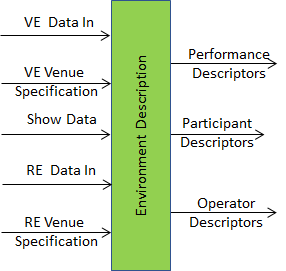| 1. Functions | 2. Reference Architecture | 3. I/O Data | 4. SubAIMs | 5. JSON Metadata | 6. Profiles |
1. Functions
The Environment Description AIM
- Extracts information from Performers and stage regarding position and orientation of performers and immersive objects and produce the Scene Descriptors with the following features:
- Use formats independent of the capturing technology, e.g.,
- For audio: Multichannel Audio, Spatial Audio, Ambisonics, etc.
- For visual: audio and raw video, volumetric, MoCap, etc.
- Allow for the following features:
- Accurate description of spatial and AV components.
- Individual accessibility and processability of objects.
- Unique association of objects with their digital representations.
- Association of the audio and visual components of input audio-visual objects.
- Use formats independent of the capturing technology, e.g.,
- Captures the mood, engagement, and choices ofparticipants (audience) expressed as:
- Visual behaviour (hand waving, standing, etc.)
- Audio reaction (clapping, laughing, booing, etc.)
- Choice (voting, motion controller, text, etc.)
- Captures commands from Operators
2. Reference Model
Figure 1 depicts the Reference Model of the Environment Description (XRV-LTP) AIM.

Figure 1 – Environment Description (XRV-LTP) AIM Reference Model.
3. I/O Data
Table 1 specifies the Input and Output Data of the Environment Description (XRV-LTP) AIM.
| Input Data | Description |
| VE Data In | Data entering the XRV-LTP instance from a Virtual Environment. |
| VE Venue Specification | Specification of the VE Venue. |
| Show Data | Input Data converted to the format of the XRV-LTP instance. |
| RE Data In | Data entering the XRV-LTP instance from a Real Environment. |
| RE Venue Specification | Specification of the RE Venue. |
| Output Data | Description |
| Performance Descriptors | Descriptors of Performers and stage. |
| Participant Descriptors | Descriptors of Participants. |
| Operator Descriptors | Descriptors of Operator. |
4. SubAIMs
?
5. JSON Metadata
6. Profiles
No Profiles.

